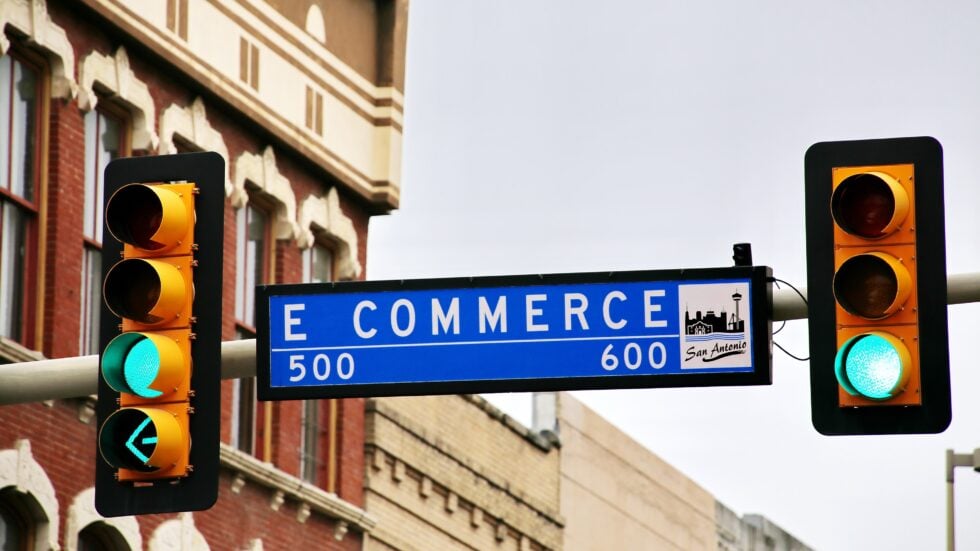“Otto…find’ ich gut” – the advertising slogan of the Otto Group, whose flagship for many years was the mail-order catalogue, is still one of the best-known advertising slogans today. With its online shop, Otto is rock solidly in second place among the most successful e-commerce retailers in Germany – right behind Amazon. On the occasion of Otto.de’s 25th anniversary, we take a closer look at the digital sales channel and dare to take a look back at the history of a group that entered uncharted territory in 1995 and pushed e-commerce in the early years more than Jeff Bezos’ tech giant.
Online retail is booming. And it has been for years. In 2019, the turnover of online trade in this country amounted to 59.2 billion euros[1] (Compare 2018: 53.4 billion). And an end to the sales increases does not seem to be in sight, especially since the Corona Crisis gave e-commerce another boost. By the end of the third quarter of 2020, the figure had already reached just under 56 billion[2] – that 2020 will be a new record year is almost certain.
From a pure catalogue retailer to an online retailer
Among the online shops with the highest turnover, Amazon.de is clearly at the top. The almighty tech giant generated almost ten and a half billion euros with its e-commerce offerings in Germany in 2019. The ten most successful web shops in our country are:

But it would be too simple and simply wrong to always associate the history and success of German online retail only with the listed US online mail order company founded by Jeff Bezos.
Because another web shop can boast that it has decisively advanced e-commerce in our country. A site that found its way onto the Internet even before Amazon and celebrated its 25th anniversary in September: Otto.de. Industry observers and e-commerce experts regard Otto as a prime example of a group that has gradually achieved a successful digital transformation. From a dusty catalogue retailer (the catalogue was nevertheless published as a printed edition until 2018) to an innovative, progressive online group that is one of the top 20 family-owned German companies in terms of sales.[3].
In this article we take a look back at the changes and the success story of the Hamburg-based trading company, not forgetting the negative headlines – of which there have certainly been a few in the course of the company’s 70-year history.
Early company history – the first years
- 1949: 40-year-old Brandenburger Werner Otto founds the “Werner Otto Versandhandel” mail-order company in Hamburg-Schnelsen.
- 1951: the first Otto catalogue appears in an edition of 300. In 14 (hand-bound) pages 28 pairs of shoes are presented

60s to 80s: From owner-managed company to corporate group
- 1960: Move into the new, huge company building in Hamburg-Bramfeld. The number of employees grows to 2000, turnover is 150 million marks.
- 1969: through the newly founded Hanseatic Bank, customers now have the opportunity to finance their catalogue or telephone orders
- From 1974: Otto acquires a stake in the mail order group “3 Suisses International” and develops into an international group with its own department stores.
- 1982: With Otto Reisen GmbH, the Group enters the tourism industry. In that year, Otto turns over almost four billion marks through mail order alone.
- 1986: With “Otto…find` ich gut” the Hamburg company establishes one of the most famous and popular advertising slogans in history.

1995: Otto goes online
1995 is the year in which the Group opens up a decisive new sales channel: sales via the digital sales platform Otto.de. Otto ventured into the Internet at a time when the Internet had not even existed for four years and was still in its infancy. The large retail groups and department stores of the time, on the other hand, did not trust “this Internet” or the new medium for a long time. It is not until three and a half years after the launch of Otto.de that Amazon’s German-language website goes online.

Just two years later, in 1997, online orders accounted for about seven percent of total sales (450 million deutschmarks) and the company invested more and more energy, money and effort in the following years:
- the expansion of the online offer
- various consulting, service and ordering functions
- user-centric user interfaces and
- new technological concepts
With success, because what was never thought possible at the beginning comes true at the end of the 00s. Exactly thirteen years after the launch of Otto.de: in 2008, e-commerce sales exceeded those of the traditional, classic sales channels for the first time.
Negative headlines
However, it was also in the 2000s that the company increasingly made the (negative) headlines due to allegedly deplorable working conditions in supplier factories and the accusation of merely pretending to be “sustainable”:
- 2005: Based on a study by the “Südwind Institute for Economy and Ecumenism”, the media accuse the company of negligence. In Chinese and Indonesian supplier factories, similarly bad conditions and working conditions are said to prevail as in those of the competition.
- 2007: in a report of the reportage and news magazine “Stern” one can read about the Indian supplier of a subsidiary of the Otto Group, which lets children work for them. And not only that – the minors are said to work in poorly lit basement dungeons on a piecework basis

- 2011: below-average pay, excessive working hours, extreme stress. This is the criticism of many who object to the unacceptable working conditions at the logistics company Hermes and its subcontractors. Hermes, which delivers a large proportion of Otto products, was once founded as an exclusive delivery service for shipping Otto Group goods.
One can at least give Otto credit for always taking criticism seriously and drawing consequences from the accusations and the negative press: Otto terminates the cooperation with partners and suppliers who have come under criticism.[4], advocates fair pay and drives projects in the areas of responsibility, the environment and sustainability.
Otto in 2020
Shopping at any time and on all channels – this is the basic principle of the retail giant, which has long since operated as a multichannel group and is considered Amazon’s most important online shopping competitor. Today, Otto.de is a modern platform with its own marketplace where other manufacturers and retailers also offer their products (at the beginning of 2017, Otto opened its shop to external providers). The app for Android and iOS also contributes to the success in the digital age. Orders placed via the Otto app already account for more than a third of total sales.
In addition, there are the stationary stores and online shops of all the companies, mail order companies and firms belonging to the Otto Group: from myToys, Bonprix and shopping24 to Quelle GmbH, About You and Baur Versand.
Otto.de in figures:
- By 10 orders per second enter Otto online or via the app
- Via three million items and almost 7000 brands can be found on Otto.de
- The company’s Facebook page has 1.1 million fans
- Just under 52 000 worldwide and around 5000 employees in Germany work for the Group.
Sources:
[1] Infographic: The top 10 online shops in Germany | Statista
[2] Online trade – turnover in Germany 2020 | Statista
[3] The 20 largest family businesses in Germany (capital.de)
[4] https://www.wiwo.de/technologie/green/kolumne-wie-nachhaltig-ist-der-versandhaendler-otto-wirklich/13545126.html
Infographic:
Infographic: The top 10 online shops in Germany | Statista
Otto advertising slogan:
https://www.otto.de/newsroom/de/kundenfokus/25-jahre-otto-de





